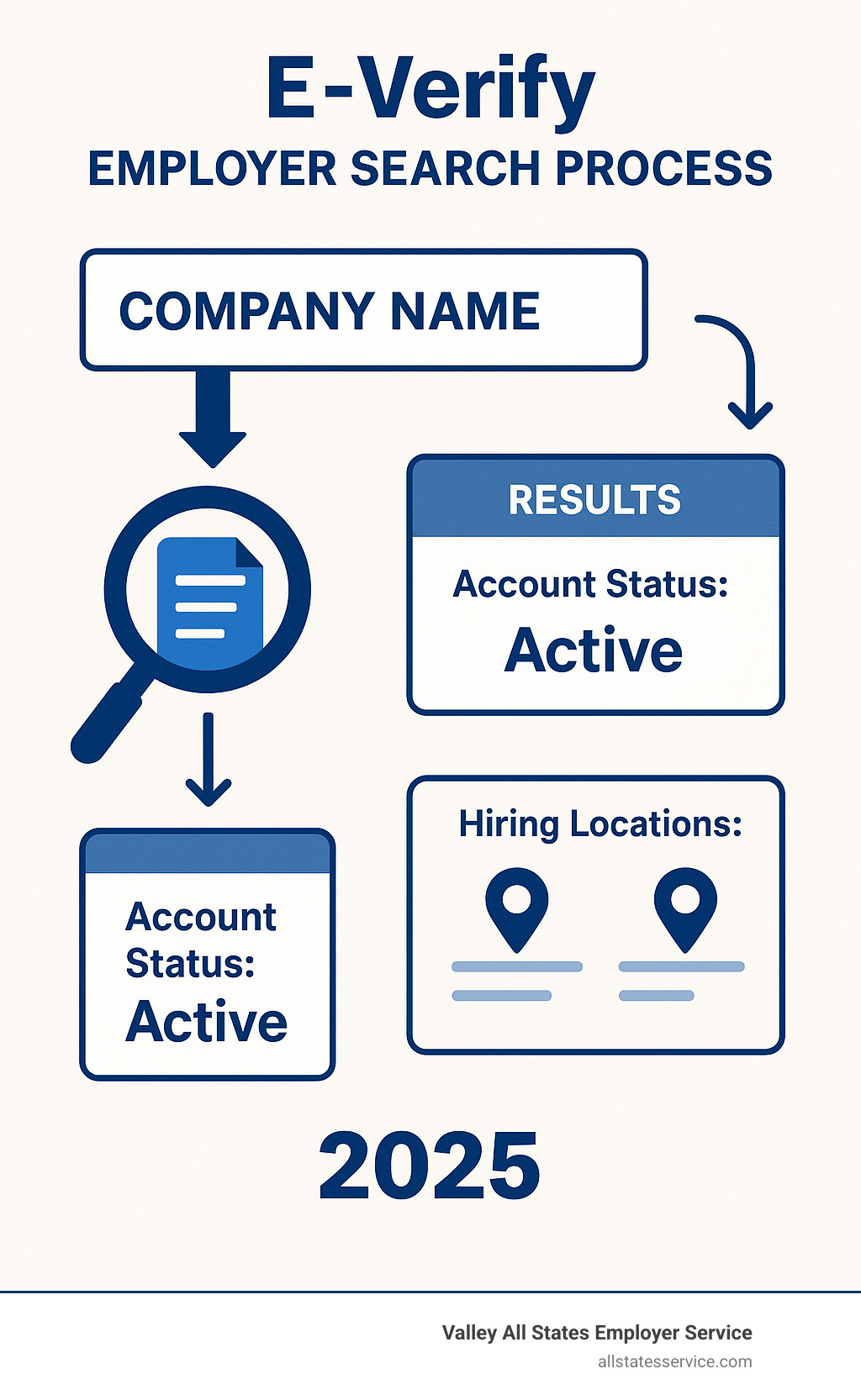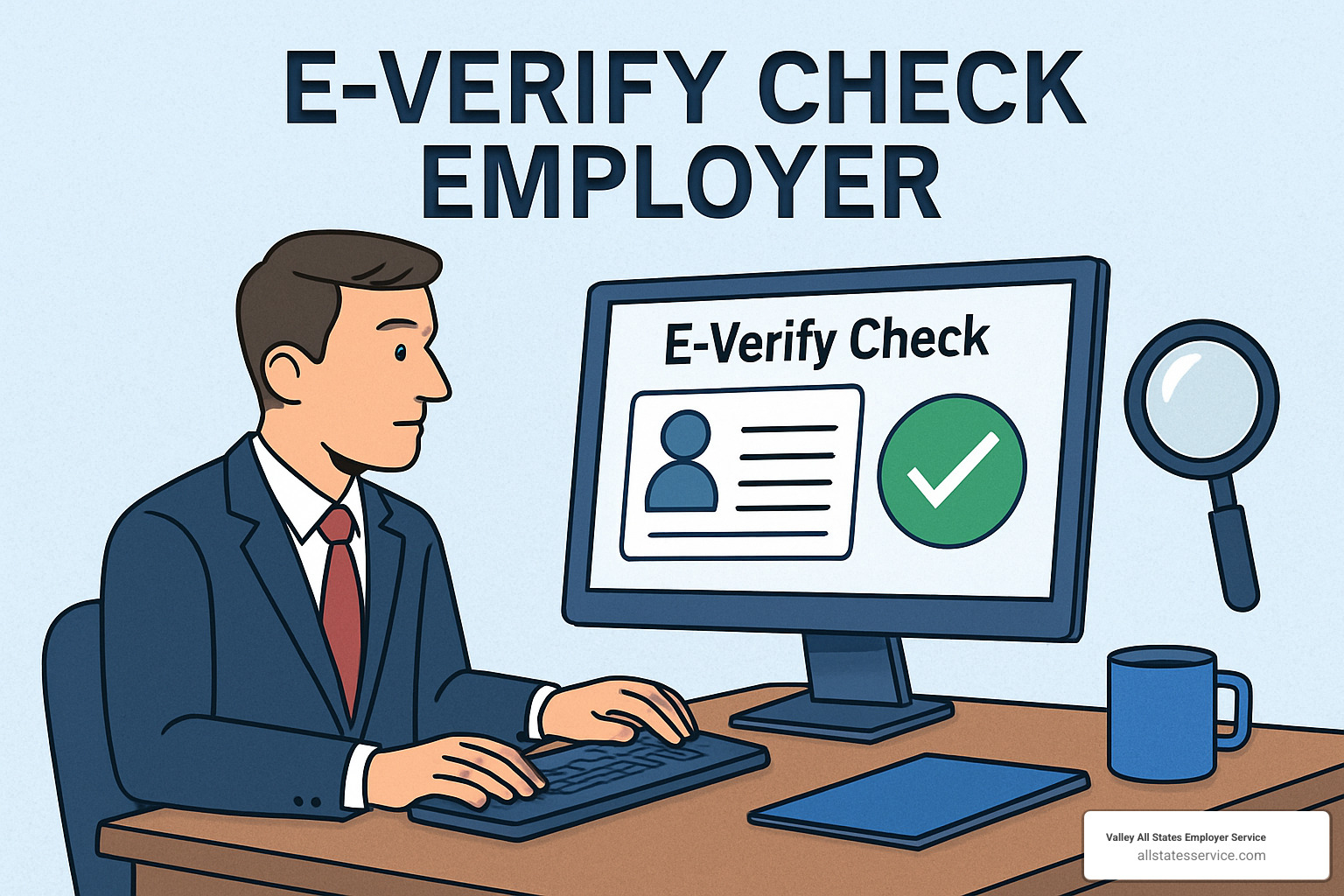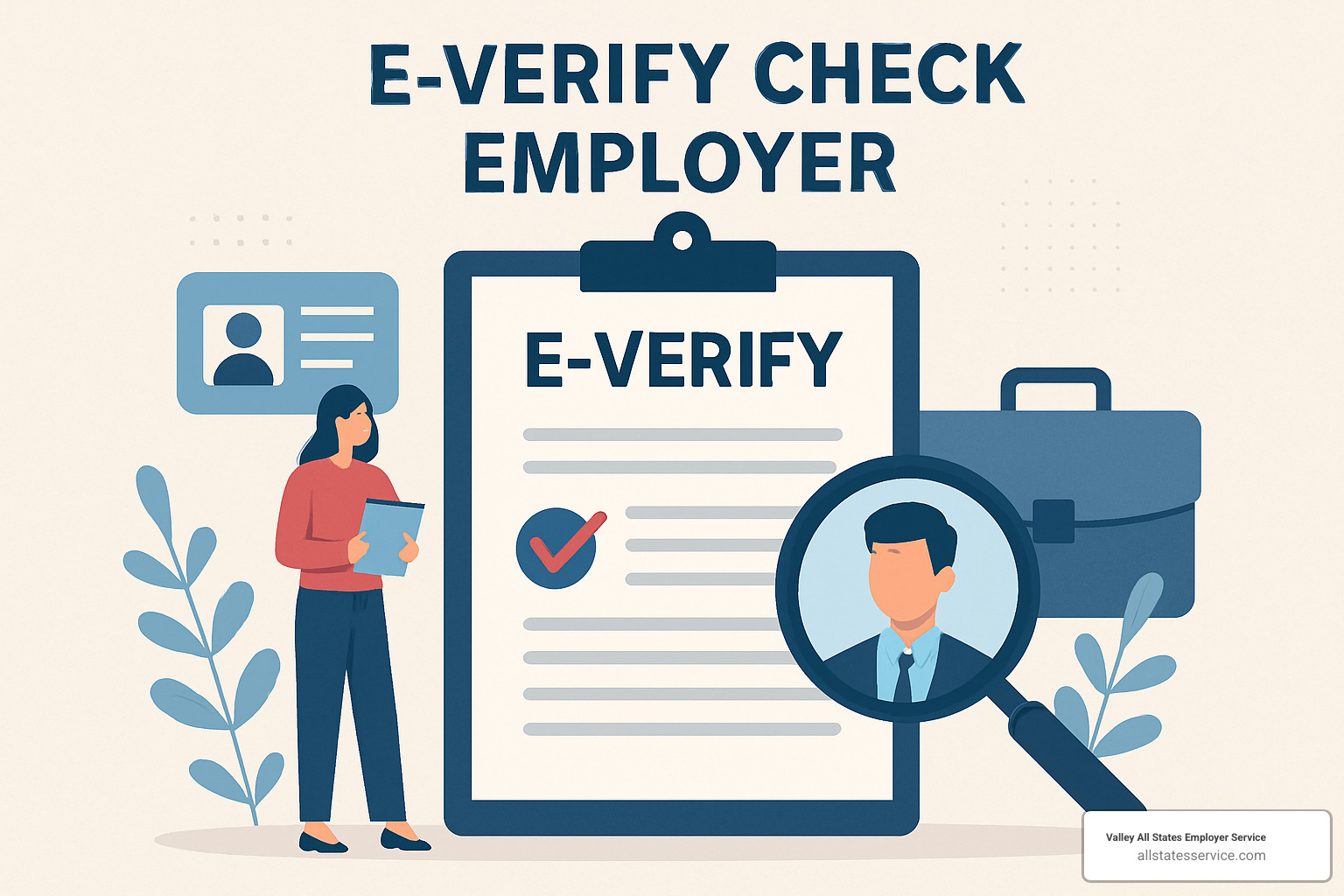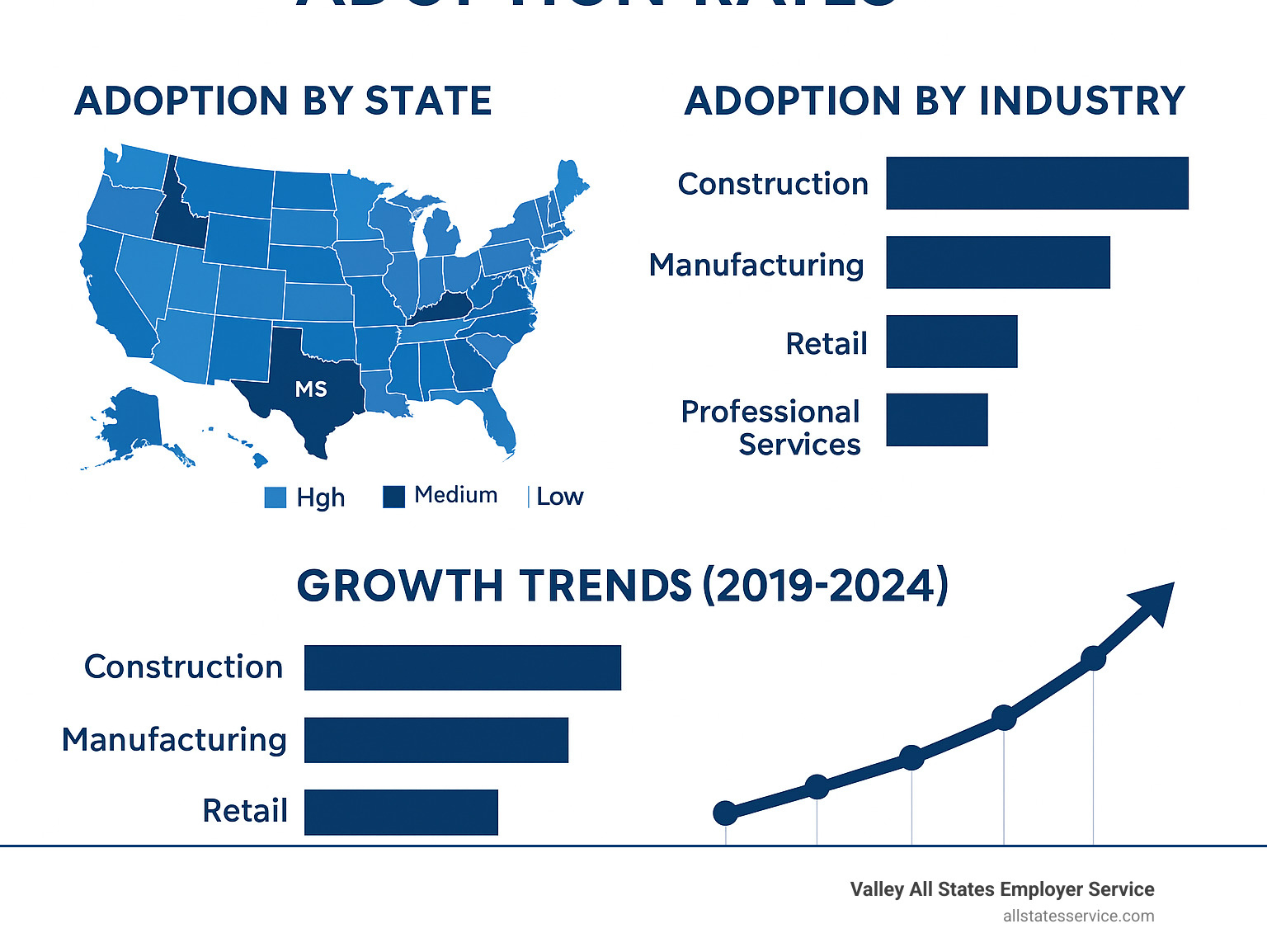Why Checking Your Employer’s E-Verify Status Matters
When you need to e verify check employer status, you’re looking for official confirmation that your current or potential workplace participates in the federal employment verification system. Here’s how to quickly check:
Quick E-Verify Employer Status Check:
- Visit the official E-Verify Employer Search Tool at e-verify.gov
- Enter the company name (try both legal name and “doing business as” name)
- Review the account status – “Active” means enrolled, “Terminated” means not participating
- Check hiring site locations – not all company locations may be enrolled
E-Verify is a secure, web-based system run by the Department of Homeland Security and the Social Security Administration. It helps confirm that new hires are authorized to work in the United States by cross-checking Form I-9 information against government databases.
Why should you care about your employer’s E-Verify status? If you’re a job seeker or current employee, knowing this information can directly impact your work eligibility, especially for STEM OPT extensions or jobs in states with strict compliance laws. According to government data, over one million U.S. companies have enrolled in E-Verify as of March 2024, with more than 1,400 new companies joining weekly.
The system also promotes transparency and trust between employers and employees. When you know your employer uses E-Verify, you understand they’re committed to following federal employment verification requirements.

Introduction: What is E-Verify and Why Should You Care?
Think of E-Verify as the government’s way of double-checking that everyone in the workplace is legally authorized to be there. This secure, web-based system is run by the Department of Homeland Security and the Social Security Administration, and it helps confirm that new hires are authorized to work in the United States by comparing Form I-9 information against government databases.
Why should you care about whether your employer uses E-Verify? The answer depends on your situation, but it can make a real difference in your career path. If you’re a job seeker, knowing your employer’s E-Verify status can directly impact your work eligibility, especially for STEM OPT extensions or jobs in states with strict compliance laws. Here’s something many people don’t realize: STEM OPT students actually need employers enrolled in E-Verify to qualify for their 24-month extension period.
Beyond the technical requirements, E-Verify also promotes transparency and trust between employers and employees. When companies voluntarily enroll in the system, they’re essentially putting up a sign that says “we’re committed to maintaining a legally authorized workforce.” This creates a more secure work environment for everyone involved.
The numbers tell an impressive story about E-Verify’s growing importance in today’s workplace. In Fiscal Year 2021, the system processed 42.5 million cases, with 98.48 percent of employees automatically confirmed as authorized to work instantly or within 24 hours. This efficiency makes E-Verify an attractive option for employers looking to streamline their hiring process while staying compliant.
The whole process flows naturally from the traditional Form I-9 verification that every employer must complete. Instead of stopping there, E-Verify takes it one step further by cross-referencing that information with government databases to provide additional confirmation.
E-Verify Overview for Employees
How to E-Verify Check an Employer: A Step-by-Step Guide

When you need to e verify check employer status, the good news is that the government makes it surprisingly easy. The E-Verify Employer Search Tool is your official, free gateway to finding out if any business participates in the system. Think of it as a phone book for employment verification, updated daily at 2 a.m. ET so you’re always getting current information.
Getting started is straightforward. Head to e-verify.gov and look for the “Employer Search” option. You’ll find yourself on a clean, simple search page that won’t overwhelm you with complicated options. The beauty of this tool is that it’s designed for regular people, not just HR professionals.
Enter your employer’s name in the search field, but here’s where it gets interesting. Companies often have multiple names, so don’t panic if your first search comes up empty. Try both the legal business name (think “Baristas Incorporated”) and the name everyone actually knows them by (“Coffee First”). Many businesses are enrolled under their formal legal name, which might be completely different from what’s on their storefront.
Smart searching saves time. If you’re dealing with a common company name and get overwhelmed with results, use the filters for state or industry to narrow things down. This is especially helpful when searching for companies like “ABC Construction” where dozens might pop up across different states.
Double-check your spelling because the system is pretty literal. A small typo can make it seem like your employer isn’t enrolled when they actually are. It’s worth trying a few variations if you’re not finding what you expect.
The small business exception. Companies with fewer than five employees might not appear in your search results, but that doesn’t mean they’re doing anything wrong. E-Verify participation isn’t required for smaller businesses in most cases.
Pay attention to hiring locations when you review your results. Large companies sometimes enroll only certain sites, not every single location. Make sure the specific office or facility where you work (or plan to work) is actually covered under their E-Verify enrollment.
The search results will show you the employer name, any “doing business as” names, account status (Active or Terminated), enrollment and termination dates, workforce size for companies with five or more employees, number of hiring sites, and which states have enrolled locations.
If something looks off in your results, you can always email E-Verify@uscis.dhs.gov for clarification. The accuracy depends on what employers report, so occasionally you might find outdated information.
Learn more about I-9 verification and compliance
Decoding the Search Results: What the Data Tells You

What do your E-Verify check employer results mean?
Once you’ve searched for an employer, you’ll see several pieces of information that might look confusing at first glance. Don’t worry, understanding these results is easier than you might think, and knowing what each field means can help you make better decisions about your employment situation.
The Account Status is your most important clue. When you see “Active,” that means the employer is currently enrolled and actively using E-Verify for new hires. This is what you want to see if you’re applying for a job that requires E-Verify verification. If you see “Terminated,” the employer is no longer participating in the program, which means they can’t run E-Verify cases for new employees.
The Enrollment Date tells you when the employer first joined E-Verify. This little detail can actually be quite revealing. Companies that have been enrolled for years often have their processes down pat and know how to handle any verification hiccups that might come up. It’s like finding out your doctor has been practicing for 20 years versus fresh out of medical school, both are qualified, but experience matters.
You’ll also see Workforce Size, but only if the employer reports having at least five employees. This is self-reported data, so it might not reflect the exact current headcount. Think of it as a general ballpark rather than an exact number. A company might report 50 employees but have grown to 75 since their last update.
Here’s where many people get tripped up: Hiring Site Locations. Not all companies enroll every single location in E-Verify. A large retail chain might enroll their corporate headquarters in Texas but not their individual stores in California. This matters because if you’re applying for a position at a location that isn’t enrolled, they can’t use E-Verify to verify your employment eligibility. Make sure your specific worksite shows up in the results.
If you see a Termination Date, don’t panic. This just means the employer used to participate but stopped for some reason. Maybe they downsized, changed their business model, or decided the voluntary program wasn’t the right fit. It doesn’t necessarily signal any problems with the company.
The database only shows employers who report having five or more employees. Smaller businesses might still use E-Verify, but they won’t appear in your e verify check employer search results. Also, you can’t tell from this tool whether an employer is a federal contractor, which would require them to use E-Verify.
E-Verify Best Practices for Employers
Your Rights in the E-Verify Process
When you’re going through the E-Verify process, you have specific rights and protections that employers must respect. Think of these as your safety net, ensuring you’re treated fairly regardless of your background or citizenship status.
Protection from discrimination is your most fundamental right. Employers cannot use E-Verify to discriminate based on citizenship, immigration status, race, color, religion, sex, age, disability, or genetic information. They also can’t play favorites by telling you which specific documents to bring from the I-9 Lists of Acceptable Documents. You get to choose which qualifying documents to present.
Here’s something that surprises many people: you have the right to work during verification. This means you can start your new job and continue working while your E-Verify case is being processed. Even if there’s a mismatch (officially called a Tentative Nonconfirmation or TNC), you don’t have to stop working while sorting things out.
If you receive a mismatch, you have eight federal government working days to contest it. This isn’t a suggestion, it’s your legal right. You can resolve mismatches using the myE-Verify tool or by contacting DHS or SSA directly. During this entire period, your employer cannot take any adverse action against you like reducing your hours or terminating your employment.
Your employer has notification responsibilities too. They must post E-Verify and Right to Work notices in English and Spanish at hiring locations. If there’s a mismatch, they’re required to provide you with a Further Action Notice explaining your rights and the steps to resolve the issue. No surprises, no confusion.
There are also actions employers cannot take. They can’t create E-Verify cases before you’re hired and complete Form I-9. They can’t use E-Verify for existing employees (except federal contractors in specific situations). And they absolutely cannot take adverse action based on a mismatch before your resolution period ends.
Want to stay informed about your case? You can check your own E-Verify case status using the myE-Verify tool at Check your E-Verify Case Status. This free service lets you monitor your case progress and helps protect your identity from potential fraud.
If you experience discrimination or unfair treatment during the E-Verify process, don’t stay silent. You can report violations at https://www.e-verify.gov/node/80. The government takes these complaints seriously and investigates potential violations thoroughly.
Employer HR Compliance Resources
Frequently Asked Questions About the E-Verify System
Is E-Verify mandatory for every company?
Here’s where things get interesting. E-Verify is voluntary for most employers, but there are some important exceptions that might surprise you. Think of it like a speed limit that applies differently depending on what road you’re driving on.
Federal contractors with contracts containing the Federal Acquisition Regulation (FAR) E-Verify clause must use the system. This means they’re checking both new hires and existing employees working on federal contracts. It’s not optional for them, it’s part of doing business with the government.
State requirements add another layer of complexity. Arizona and Mississippi require most employers to use E-Verify, while other states have requirements specifically for public agencies or contractors. The landscape keeps evolving, with more states considering similar legislation each year. You can review the latest rules with the official E-Verify state laws map.
Many private employers choose to enroll voluntarily because they want to demonstrate their commitment to maintaining a legally authorized workforce. This can be particularly valuable for companies in industries with strict compliance requirements or those looking to stand out in competitive markets.
Can an employer use E-Verify before I accept a job offer?
Absolutely not. This is one of the most important rules in the E-Verify system. Employers cannot use E-Verify to prescreen job applicants. The system can only be used after you’ve accepted a job offer and completed Form I-9.
Think of it as a security checkpoint at the airport. You can’t go through security until you have a boarding pass. Similarly, employers can’t run your information through E-Verify until you’re officially hired.
The timing is specific and protected. Employers must create E-Verify cases no later than the third business day after you start work for pay. This timing ensures that the verification process doesn’t interfere with your right to work while maintaining the system’s integrity.
Using E-Verify for prescreening would violate the program’s terms and could result in the employer’s termination from the system. It would also potentially violate anti-discrimination laws, which is why the rule exists in the first place.
Employee Onboarding Compliance
What if my e verify check employer search comes up empty?
Don’t worry if your e verify check employer search doesn’t return results. There are several perfectly normal reasons why this might happen, and most of them aren’t cause for concern.
Try searching with different company names first. A company might be enrolled under their legal name “Baristas Incorporated” but everyone knows them as “Coffee First.” Search using both the company’s legal name and any “Doing Business As” names they might use publicly.
Small businesses often don’t appear in search results. Companies with fewer than five employees may not show up in the public database, even if they’re enrolled in E-Verify. This is just how the system works, not a red flag.
Consider that the employer might not be required to participate. If they’re not a federal contractor and don’t operate in a state with mandatory E-Verify laws, they may have chosen not to enroll. That’s completely legal and normal.
Recent changes can cause temporary gaps. If the company recently enrolled or terminated participation, there might be a brief delay in the database updates, though the system refreshes daily at 2 a.m. ET.
When in doubt, ask directly. You can contact HR or hiring managers about their E-Verify status. Legitimate employers should be transparent about their participation in the program. If they seem evasive or unclear, that might be worth noting as you evaluate the opportunity.

Ensuring a Smooth and Compliant Hiring Process
Checking an employer’s E-Verify status helps you make informed decisions and ensures compliance for both sides of the employment relationship. When you e verify check employer status before accepting a job offer, you’re setting yourself up for a smoother hiring experience without unexpected delays or documentation surprises.
For job seekers, this knowledge creates realistic expectations about the hiring timeline and documentation requirements. You’ll know whether to expect additional verification steps beyond Form I-9 completion. This becomes particularly important if you’re on a temporary visa, have a complex immigration situation, or need your employer to be E-Verify enrolled for benefits like STEM OPT extensions.
For employers, using E-Verify correctly reduces errors and builds genuine trust with your team. The system’s impressive 98.48% automatic confirmation rate means most cases resolve quickly, creating that smooth onboarding experience everyone wants. However, proper implementation requires understanding the rules and maintaining compliance with all requirements, not just clicking through the system.
The reality is that common compliance challenges can trip up even well-intentioned employers. Timing violations happen when companies create cases too early or too late. Discrimination issues arise when employers don’t understand proper procedures. Improper handling of Tentative Nonconfirmations can create unnecessary stress for new hires. These problems can result in system termination, legal liability, and seriously damaged employer-employee relationships.
Best practices for smooth E-Verify processing start with maintaining accurate Form I-9 records and training HR staff on proper procedures. Smart employers display required notices prominently and have clear, written processes for handling mismatches. They also ensure they’re not selectively applying E-Verify to certain employees while exempting others, which creates both legal and morale problems.
At Valley All States Employer Service, we understand these complexities because we deal with them every day. Our expert team provides comprehensive support for E-Verify enrollment, case processing, and compliance management. We help employers steer the system’s requirements while minimizing administrative burden and reducing the risk of those costly mistakes that keep HR directors awake at night.
Our services cover the full spectrum: complete E-Verify case management, Form I-9 verification assistance, compliance training, and ongoing support for handling complex situations. We work with companies of all sizes, from small businesses enrolling for the first time to large corporations managing thousands of verifications annually.
The employment verification landscape keeps evolving, with new requirements and best practices emerging regularly. Staying current requires dedicated attention and expertise that most businesses simply don’t have time for. We monitor regulatory updates and help our clients adapt to new requirements seamlessly, so they can focus on what they do best.
Learn more about our E-Verify services
Ready to simplify compliance? Contact our team today.
Whether you’re an employee checking your employer’s verification status or a business owner looking to implement E-Verify, understanding the system’s requirements and processes makes everything easier. The e verify check employer function provides transparency and helps ensure everyone understands their rights and responsibilities in the employment verification process.
By following the steps outlined in this guide, you can quickly determine any employer’s E-Verify status and make informed decisions about your employment situation. E-Verify works best when it creates a fair, efficient system for confirming work authorization that protects both employers and employees.